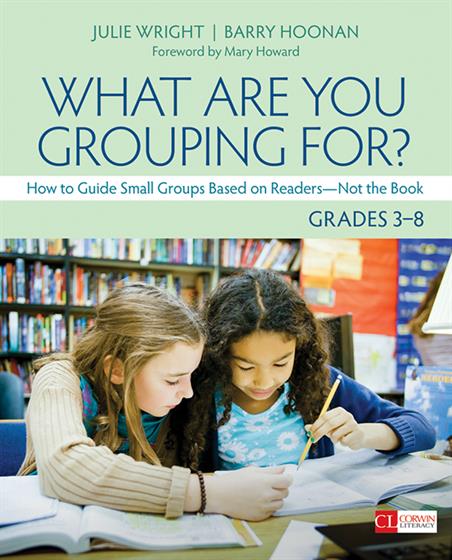Hands-on, Practical Guidance for Educators
From math,
literacy, equity, multilingual learners, and SEL, to assessment, school counseling,
and education leadership, our books are research-based and authored by experts
on topics most relevant to what educators are facing today.

What Are You Grouping For?, Grades 3-8
Foreword by Mary Howard
- Grade Level: 3-8
- ISBN: 9781544324128
- Published By: Corwin
- Series: Corwin Literacy
- Year: 2018
- Page Count: 352
- Publication date: July 26, 2018
Review Copies
Review copies may be requested by individuals planning to purchase 10 or more copies for a team or considering a book for adoption in a higher ed course. Request review copy
Description
Bring out daring readers with dynamic small groups!
Like many educators in intermediate classrooms across the country, you may be using guided reading principles to teach reading. Whether you’re following targeted reading levels or sticking with your school’s established routines, chances are that guided reading has become synonymous with small group reading for you and your students. But . . . are your students getting the most out of small groups? Are readers of all ability levels experiencing the dynamic learning that can occur in small groups? Do you feel confident that the way you’re grouping kids is based on their wants and needs?
Intermediate grade readers don’t need to be guided as much as they need to be engaged—and authors Julie Wright and Barry Hoonan have solutions for doing just that using small groups. What Are You Grouping For? offers the practical tools, classroom examples, and actionable steps essential for starting, sustaining, and mastering the management of small groups. This book explains the five teacher moves that work together to support students’ reading independence through small group learning—kidwatching, pivoting, assessing, curating, and planning—and provides examples to guide you and your students toward success.
From must-have beginning-of-the-year strategies to step-by-step advice for implementation, this guide breaks down the processes that support small groups and help create effective instructional reading programs. Based on more than 45 years of combined experience in the classroom, this resource will empower you with tools to ensure that your readers are doing the reading, thinking, and doing—not you.
Author(s)

Julie Wright
JULIE WRIGHT is a teacher, instructional coach, and educational consultant with over twenty-five years of experience in rural, suburban, and urban education settings. She holds National Board Certification as well as a B.S. in education, a master’s in language arts and reading, a reading endorsement, and extensive school leadership post-graduate work, including a pre-K through grade 9 principal license from The Ohio State University. She has served as an adjunct faculty member at Ashland University and University of Wisconsin, teaching graduate courses focused on curriculum, instruction, and assessment and instructional coaching respectively. Julie gets her inspiration from her husband, David, and their three children, Sydney, Noah, and Max.

Barry Hoonan
BARRY HOONAN teaches fifth and sixth grade at Odyssey Multiage Program on Bainbridge Island, Washington. He works with teachers both in the U.S. and internationally, including appointments as a three-time Fulbright Teaching Exchange teacher in the United Kingdom, a teaching fellow at Harlem Village Academy in NYC, and next year— a teacher-consultant at the American School of Brasilia. Barry is a co- author of Beyond Reading and Writing: Inquiry, Curriculum, and Multiple Ways of Knowing (NCTE, 2000), and is a recipient of NCTE’s Edward Hoey Award and of the Bonnie Campbell Hill Washington State Literacy Award.
Table of Contents
Foreword by Mary Howard
Acknowledgments
Preface
CHAPTER 1. A New Way of Thinking About Small Group Learning Experiences (because being up close to students is what drives discovery)
Small Group Instruction Redefined
The Five Teacher Moves
Combating the Challenges So You Can Do the Five Moves
One Last Thing
CHAPTER 2. The Launch (because who doesn’t need beginning-of-the-year strategies)
Small Groups Defined
Two Essential Questions This Chapter Helps You Answer
Beliefs
Ideas for the First Days of School
Listening In and Joining In
A Few Weeks Into the School Year
One Last Thing
CHAPTER 3. Scheduling (because schedules are key for the launch and beyond)
Reading Workshop: Daily Plans for Groups
Getting Started, Quick Groups
Groups for First Days/Weeks of School
Groups That Might Meet Across the Year
Small Group Foundational Q&A
One Last Thing
CHAPTER 4. Kidwatching 2.0 (because it’s all about orient, notice, take stock, and inquire)
Two Essential Questions This Chapter Helps You Answer
Beliefs
Our Kidwatching 2.0 Protocol
Tips for Getting Started
Using Your Notes to Form Small Groups
Four-Step Process for Going From Kidwatching to Small Group
Example of Small Group Work Based on Kidwatching Data
One Last Thing
CHAPTER 5. Pivoting Into Flexible Groups (because it’s the teacher moves that keep readers moving forward)
Two Essential Questions This Chapter Helps You Answer
Beliefs
How This Chapter Is Organized
The List of Reasons for Pivoting
The Teacher’s Role
Types of Groups to Pivot Into and Out Of
Timing Is Everything: More About the Duration of Groups
Language for Joining In
Troubleshooting
One Last Thing
CHAPTER 6. Assessing Student Work (because looking at our readers’ work lifts their strategies, skills, and thinking)
Two Essential Questions This Chapter Helps You Answer
Beliefs
Assessing With Learner-Centered Benchmarks
What to Look At
How to Sort Student Work
Planning a Focus for Instruction and Putting It Into Action
More Examples of How to Use Work to Inform Grouping Decisions
One Last Thing
CHAPTER 7. Curating (because selecting the right texts inspires readers to be connoisseurs)
Two Essential Questions This Chapter Helps You Answer
Beliefs
Teachers and Students as Curators
Teachers as Curators
Steps for Curating
Zooming In on Step 2: Curate and Select
Zooming In on Step 3: Decide
Steps 4–7: Spark, Read and Construct Meaning, and Reflect
Students as Curators
Exemplars of Students as Curators
One Last Thing
CHAPTER 8. Unit Planning (because small groups are best anchored in a harbor of big ideas)
Two Essential Questions Chapters Eight and Nine Help You Answer
Beliefs
Planning: The Reality Show
Six Surefire Steps
One Last Thing
CHAPTER 9. Weekly and Daily Planning (because weekly and daily plans chart the course for small group experiences)
Creating a Calendar for Weekly and Daily Lesson Planning
Zooming In on Step 5: Make Plans for Small Group Learning Opportunities
Some Popular, Proven Models to Guide You
Barry’s Planning Process for Hosting Two Groups
Julie’s One-Week Plan of Lessons for Launching a Unit
Student-Driven Planning
Putting It Into Practice: Examples From Our Classrooms
One Last Thing
Conclusion
Appendix: Ready-to-Copy Teacher and Student Reflection/Planning Pages
References and Further Reading
Index
About the Authors
Reviews
“A few years back, after visiting Barry Hoonan’s classroom and experiencing his teaching and his students’ learning, I looked squarely into his reflective eyes and said, ‘Please write a book about what I just saw.’ Educators, welcome to Barry and Julie’s classrooms. Their most important thinking and learning has been poured into this book for us, the virtual visitors to their rooms. They invite us into their joy-filled classrooms, engaging us as their colleagues. We learn alongside them by listening in to their conversations with their students, and kidwatch by joining in their thinking and discovering students’ next steps. We lean into their questions and inquiry as the authors share their reverence for teaching, respect of all students, and above all, how we are doing this together because ‘exquisite things that happen when we are inquisitive together.’”Gail Boushey
Co-Author of The Daily 5: Fostering Literacy Independence in the Elementary Grades and Co-Founder of The Daily Café
“ This book is a fresh reminder that the best teaching is responsive—that kids are much more likely to flourish when they have a teacher whose primary focus is on teaching students rather than on teaching stuff. Julie Wright and Barry Hoonan effectively argue that the one of the best ways to be responsive to your students is through small-group learning experiences, and the five teacher moves they outline in this book—kidwatching, pivoting, assessing, curating, and planning—are moves that should be woven through all K–12 classrooms. I highly recommend this book.”Kelly Gallagher
Teacher and Author of Readicide: How Schools Are Killing Reading and What You Can Do About It and Write Like This
“ In this nimble and invigorating profile of small group settings, Julie Wright and Barry Hoonan offer practical tools and actionable steps that lift small group instruction from a static focus on reading levels to one of setting learning in motion. They outline five critical teacher moves—kidwatching, pivoting, assessing, curating, and planning—that work together to help teachers take a flexible stance while elevating learner responsibility.”Linda Hoyt
Author of Revisit, Reflect, Retell: Time-Tested Strategies for Teaching Reading Comprehension
“ The authors reframe, redefine, and refresh the notion of small group reading instruction. In doing so, they remind us that small group instruction is not only for our ‘struggling’ students, but rather that it’s about leaning in and meeting all students where they are so that we can move them forward. This gem of a book includes strategies for engaging students as readers, encouraging voluminous reading, and finding joy in our reading instruction. It’s a must-read for any elementary teacher of reading.”Diane Sweeney
Author of Student-Centered Coaching: The Moves
“ Wherever I go, teachers ask me about small group instruction and how to do it. At last, there is book with systems and structures that make small group instruction manageable and meaningful. Julie Wright and Barry Hoonan provide lots of examples to show how to honor and meet the individual needs of students.”Cris Tovani
Teacher, Author of I Read It, But I Don’t Get It and Do I Really Have to Teach Reading?, and Instructional Coach
“ These teaching moves are just what I needed to refine my flexibility and problem-solving sophistication in small group instruction. The strategies and examples read as the encouraging voices of the authors over my shoulder, grounded in powerful beliefs, inspiring me to open up my classroom practices in the quest for empowering and joyful student-centered learning. With specific, easily implementable steps to bridge the gap between the formula of best practices in differentiation and the heart and soul of giving each student what they need today for powerful learning, this book is an essential handbook for new and experienced teachers.”Shelley Hays
Upper Arlington City Schools
“ For anyone who is looking to lift small group instruction to make it more meaningful, efficient, and joyful, this book is for you. Whether you are someone who is just embarking on utilizing small groups or are looking to breathe new life into this structure, the authors hold your hand and walk you through innovative, practical, and student-centered approaches to reading instruction. Because of this book, there is no longer just one way to hold a guided reading group or a coach book club. The roles a teacher can assume are now dynamic and flexible within small groups and the authors show us how to customize instruction with confidence and insight, adjusting for the readers in front of us. This book is the next generation of small group instruction.”Patty McGee
Author of Feedback That Moves Writers Forward
“ Julie Wright and Barry Hoonan’s insistence on JOY at the heart of every instructional decision ensures that a teacher’s focus is not on the structure, but on each child—what they know, what they can do, and what they need next to grow—which is as it should be. One of my favorite lines is, ‘Students’ curiosity and interests are more trustworthy and energizing drivers of grouping decisions than anything else.’ What Are You Grouping For? will energize YOU as you plan worthy work for your students and focus on compelling reasons for them to read, write, and talk. Trust Julie and Barry when they say in the first pages, ‘Together, we’ll figure it out.’ Thanks, Julie and Barry, for being our wing-people. Kids need us to work together and model courageous risk taking in our classrooms. Together is the best way forward.”Samantha Bennett
Author of That Workshop Book
“ It’s pretty rare these days to find a book that fills both our minds and our pockets. But Julie Wright and Barry Hoonan’s What Are You Grouping For? does just that. It meets us exactly where we are as teachers, with all our questions and concerns, about time and organization and materials and strategies, and helps us not only understand what’s possible, but how to enact it too. This is the book to keep in our laps as we teach. Thank you, Barry and Julie!”Donna Santman
Middle school English Teacher, New York City; Author of That Workshop Book
“ Barry and Julie have produced a must-read book for teachers of reading. This work is a practical guide to the use of small group instruction as a means of improving reading skills. These two master teachers provide clear, focused techniques from their own practice while making a case for ‘less is more’ relative to taking on too many initiatives in schools. This is thoughtful and provocative.”Allan Bredy
American School of Brasilia, Brazil
“ Julie Wright and Barry Hoonan have hit the ‘sweet spot’ of helping each student become exquisite readers. Through authentic classroom examples, they demonstrate how small groups are the fulcrum between one-to-one instruction and whole group instruction. This book is a gift to educators desiring to create voluminous readers!”Michael Nelson
Enunclaw School District, Enumclaw, WA
“ Julie Wright and Barry Hoonan take us on an adventure, redefining small group instruction and broadening our vision of what it can look like when we carefully plan and then step aside and take note of student interactions. With ‘five teacher moves,’ Julie and Barry talk us through meaningful strategies for employing a variety of fluid and flexible small group instruction and work where students ‘think about and appreciate texts.’ Julie and Barry share ideas for getting started, as well as specific examples of small groups that will inspire students all year. This book is for every teacher who strives to create meaningful small group instruction and work in their classrooms.”Megan Sloan
Author of Into Writing: The Primary Teacher’s Guide to Writing Workshop
“ What Are You Grouping For? is a must-have resource. Julie Wright and Barry Hoonan give practical strategies followed with examples from the classroom for supporting students’ reading independence through small groups. This book incorporates the importance of building relationships and knowing your students to gain maximum impact in the classroom. The book leaves the reader motivated and inspired to get started tomorrow!”Amber Reed
Albia Community School District
Review Copies
Review copies may be requested by individuals planning to purchase 10 or more copies for a team or considering a book for adoption in a higher ed course. Request review copy
Related Resources
-
3 Ways to Re-imagine Small-Group Reading Experiences
[Blog] - Access to companion resources is available with the purchase of this book.
-
Kidwatching 2.0: Top 3 Moves for Real-time Assessment to Meet Every Students' Needs
[Blog] -
The Difference Between Guided Reading and Small Group Instruction
[Lessons and Strategies] -
Want to Inspire Voluminous Reading? Start with Curating Texts
[Blog]
Join us for the Visible Learning
Conference in Las Vegas!
Experience groundbreaking research, inspiring speakers,
and transformative networking. Register Now.

